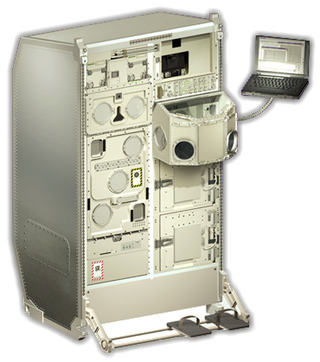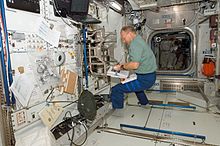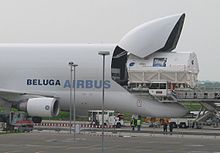
The International Space Station (ISS) is the largest space station to have ever been built. The station resides in low Earth orbit and has a primary purpose of performing microgravity and space environment experiments. As implied by its name, the International Space Station is a collaboration of five national space agencies and other contractors. These agencies are: NASA, Roscosmos (Russia), JAXA (Japan), ESA (Europe), and CSA (Canada).

Spacelab was a reusable laboratory developed by European Space Agency (ESA) and used on certain spaceflights flown by the Space Shuttle. The laboratory comprised multiple components, including a pressurized module, an unpressurized carrier, and other related hardware housed in the Shuttle's cargo bay. The components were arranged in various configurations to meet the needs of each spaceflight.

The Automated Transfer Vehicle, originally Ariane Transfer Vehicle or ATV, was an expendable cargo spacecraft developed by the European Space Agency (ESA), used for space cargo transport in 2008–2015. The ATV design was launched to orbit five times, exclusively by the Ariane 5 heavy-lift launch vehicle. It effectively was a larger European counterpart to the Russian Progress cargo spacecraft for carrying upmass to a single destination—the International Space Station (ISS)—but with three times the capacity.

The Japanese Experiment Module (JEM), nicknamed Kibō, is a Japanese science module for the International Space Station (ISS) developed by JAXA. It is the largest single ISS module, and is attached to the Harmony module. The first two pieces of the module were launched on Space Shuttle missions STS-123 and STS-124. The third and final components were launched on STS-127.

A Multi-Purpose Logistics Module (MPLM) is a large pressurized container that was used on Space Shuttle missions to transfer cargo to and from the International Space Station (ISS). Two MPLMs made a dozen trips in the Shuttle cargo bay and initially berthed to the Unity module and later the Harmony module on the ISS. From there, supplies were offloaded, and finished experiments and waste were reloaded. The MPLM was then reberthed in the Shuttle for return to Earth. Three modules were built by the Italian Space Agency (ASI): Leonardo, Raffaello, and Donatello.

The Cupola is an ESA-built observatory module of the International Space Station (ISS). Its name derives from the Italian word cupola, which means "dome". Its seven windows are used to conduct experiments, dockings and observations of Earth. It was launched aboard Space Shuttle Endeavour's mission STS-130 on 8 February 2010, and attached to the Tranquility module. With the Cupola attached, ISS assembly reached 85 percent completion. The Cupola's central window has a diameter of 80 cm (31 in).

The Unity connecting module, also known as Node 1, is the first U.S.-built component of the International Space Station (ISS). It connects the Russian and United States segments of the station, and is where crew eat meals together.

The Destiny module, also known as the U.S. Lab, is the primary operating facility for U.S. research payloads aboard the International Space Station (ISS). It was berthed to the Unity module and activated over a period of five days in February, 2001. Destiny is NASA's first permanent operating orbital research station since Skylab was vacated in February 1974.

Harmony, also known as Node 2, is the "utility hub" of the International Space Station. It connects the laboratory modules of the United States, Europe and Japan, as well as providing electrical power and electronic data. Sleeping cabins for four of the crew are housed here.

STS-122 was a NASA Space Shuttle mission to the International Space Station (ISS), flown by the Space ShuttleAtlantis. STS-122 marked the 24th shuttle mission to the ISS, and the 121st Space Shuttle flight overall.

Biolab is a single-rack multi-user science payload designed for use in the Columbus laboratory of the International Space Station. Biolab support biological research on small plants, small invertebrates, microorganisms, animal cells, and tissue cultures. It includes an incubator equipped with centrifuges in which the preceding experimental subjects can be subjected to controlled levels of accelerations.

The European Technology Exposure Facility (EuTEF) was a payload mounted on the exterior of the European Columbus laboratory, one of the modules of the International Space Station. The facility, mounted onto the exterior of Columbus, provided a platform for multiple types of experiments and materials to be exposed directly to the harsh space environment.

The US Orbital Segment (USOS) is the name given to the components of the International Space Station (ISS) constructed and operated by the United States National Aeronautics and Space Administration (NASA), European Space Agency (ESA), Canadian Space Agency (CSA) and Japan Aerospace Exploration Agency (JAXA). The segment consists of eleven pressurized components and various external elements, all of which were delivered by the Space Shuttle.

The Columbus External Payload Facility (Columbus-EPF) is a component of the Columbus module on the International Space Station. It consists of two identical L-shaped consoles attached to the starboard cone of Columbus in the zenith (top) and nadir (bottom) positions, each supporting two platforms for external payloads or payload facilities. Four external payloads can be operated at the same time.

The Columbus Man-Tended Free Flyer (MTFF) was a European Space Agency (ESA) program to develop a space station that could be used for a variety of microgravity experiments while serving ESA's needs for an autonomous crewed space platform. It consisted of a Columbus module docked to a service module containing solar power collectors, communications and other services. The program ran from 1986 to 1991, was expected to cost $3.56 billion including launch and utilization, and was cancelled while still in the planning stage. Aspects of the program were later realised in the Columbus science laboratory attached to the International Space Station (ISS).

The European contribution to the International Space Station comes from 10 members of the European Space Agency (ESA) and amounts to an 8% share in the programme. It consists of a number of modules in the US Orbital Segment, ATV supply ships, launchers, software and €8 billion.

The European Service Module (ESM) is the service module component of the Orion spacecraft, serving as its primary power and propulsion component until it is discarded at the end of each mission. In January 2013, NASA announced that the European Space Agency (ESA) will contribute the service module for Artemis 1, based on the ESA's Automated Transfer Vehicle (ATV). It was delivered by Airbus Defence and Space in Bremen, in northern Germany to NASA at the end of 2018. After approval of the first module, the ESA will provide the ESMs from Artemis 2 to Artemis 6.
Airbus Defense and Space is the division of Airbus SE responsible for the development and manufacturing of the corporation's defense and space products, while also providing related services. The division was formed in January 2014 during the corporate restructuring of European Aeronautic Defense and Space (EADS), and comprises the former Airbus Military, Astrium, and Cassidian divisions. It is the world's second-largest space company after Boeing and one of the top ten defense companies in the world.

The project to create the International Space Station required the utilization and/or construction of new and existing manufacturing facilities around the world, mostly in the United States and Europe. The agencies overseeing the manufacturing involved NASA, Roscosmos, the European Space Agency, JAXA, and the Canadian Space Agency. Hundreds of contractors working for the five space agencies were assigned the task of fabricating the modules, trusses, experiments and other hardware elements for the station.
The German space programme is the set of projects funded by the government of Germany for the exploration and utilisation of outer space. The space programme is run by the German Aerospace Center, who conduct research, plan, and implement the programme on behalf of the German federal government.

































